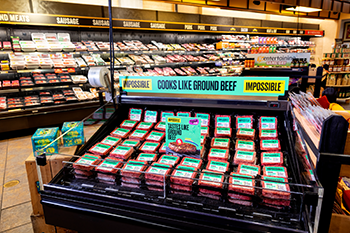By: Rick Stein, Vice President, Fresh, Industry Relations, FMI

Today in the food industry, there are thousands of companies riding the wave of the plant-based protein trend. Grocery stores, restaurants and even convenience stores are on the road to wide-spread plant-based offerings. Five years ago, a plant-based eater would only have a small selection offered on grocery shelves and would never think they could walk into a fast-food restaurant to enjoy a satisfying meal.
Household Preferences Changing
FMI’s 2019 U.S. Grocery Shopper Trends report finds a rising number of households (33%) have at least one member voluntarily following a vegan, vegetarian, pescatarian or flexitarian diet—a trend which is higher for Gen Z and Millennial households. Plant-based proteins are foods that can fit into many of these unique diets, therefore, a growing number of shoppers are turning to them to help meet their unique household needs.
At the same time, Trends finds only 5% of households with kids describe themselves as eating a completely plant-based diet, meaning the exclusion of all animal products including meat, dairy, and eggs. So, how is it that plant-based meat alternatives, in a society where plant-based meats used to seem alien, are so popular?
Cue the Flexitarians
Flexitarian lifestyles are increasingly prevalent. FMI’s Power of Meat 2019 report defines flexitarianism as eating mostly a vegetarian diet, but occasionally eating meat and poultry. Among Gen Z, 13% eat a flexitarian diet versus just 6% of Older Boomers. Millennials and Gen X average 10% each for eating flexitarian diets. Women, at 15%, are also more likely to be flexitarians than men, at 6%. Sustainability and health concerns are helping to drive the flexitarian trend and increase plant-based protein options have more people experimenting with these new food options.
Responding to Flexitarians
Companies that push plant-based products cater their products to consumers who are mixing up their diets beyond just meat. For example, when fast-food chains release plant-based options they usually serve them with mayonnaise and cheese, showing that they are not attempting to cater specifically towards people following strict plant-based diets, but people who want to swap the meat patty for something that may make them feel better about their dietary choices.
Plant-based meat alternatives are not just booming in restaurants. They are also flying off grocery store shelves. The Power of Meat 2019 report finds that plant based-meat alternative sales increased by 19.2% last year and account for $878 million in annual sales.
It cannot be denied that the rise of flexitarianism is inspiring the abundance of meatless innovations hitting the market. The plant-based food industry has seen explosive growth in the past few years, and there is plenty more to come. With the growing acceptance of plant-based foods and product offerings cutting across grocery categories and sales growth, FMI is providing a webinar series to share marketplace innovations, expand understanding of the plant-based consumer, dive into shopping trends and understand the labeling, naming compliance and regulatory landscape.
Plant-based Foods Growing Like a Weed?
Enjoy our series recordings and upcoming complimentary webinars to learn more on the plant-based product innovations and sales trends.
Recording: The Plant-Based Tipping Point
Recording: The Surge of Plant-Based Foods
Recording: From Plant-Based to Cell-Cultured: A Regulatory Update on Alternatives for Traditional Food Items
Recording: Understanding the Plant-Based Food Consumer


 Industry Topics address your specific area of expertise with resources, reports, events and more.
Industry Topics address your specific area of expertise with resources, reports, events and more.
 Our Research covers consumer behavior and retail operation benchmarks so you can make informed business decisions.
Our Research covers consumer behavior and retail operation benchmarks so you can make informed business decisions.
 Events and Education including online and in-person help you advance your food retail career.
Events and Education including online and in-person help you advance your food retail career.
 Food Safety training, resources and guidance that help you create a company food safety culture.
Food Safety training, resources and guidance that help you create a company food safety culture.
 Government Affairs work — federal and state — on the latest food industry policy, regulatory and legislative issues.
Government Affairs work — federal and state — on the latest food industry policy, regulatory and legislative issues.
 Get Involved. From industry awards to newsletters and committees, these resources help you take advantage of your membership.
Get Involved. From industry awards to newsletters and committees, these resources help you take advantage of your membership.
 Best practices, guidance documents, infographics, signage and more for the food industry on the COVID-19 pandemic.
Best practices, guidance documents, infographics, signage and more for the food industry on the COVID-19 pandemic.
